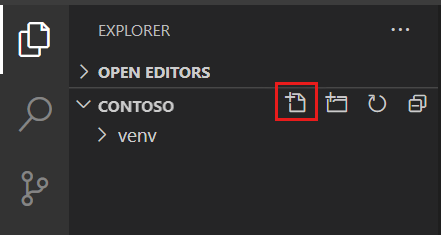Exercise - Create an app
We're going to create our application iteratively, focusing on specific concepts as we go. To start, we'll create the landing page for our application, which will display the form the user will use.
Typically, the entry point for Flask applications is a file named app.py. We're going to follow this convention and create the core of our application. We'll perform the following steps:
- Create our core application
- Add the route for our application
- Create the HTML template for our site
- Test the application
Create core application
Returning to the instance of Visual Studio Code we were using previously, create a new file named app.py by clicking New file in the Explorer tab

Important
If this exercise is your first time using Visual Studio Code to create a Python application, you'll receive messages about installing the Python extension and the linter pylint. Select Install to install each of these add-ons.
Add the code to create your Flask application
from flask import Flask, redirect, url_for, request, render_template, session app = Flask(__name__)
The import statement includes references to Flask, which is the core of any Flask application. We'll use render_template in a while, when we want to return our HTML.
app will be our core application. We'll use it when we register our routes in the next step.
Add the route
Our application will use one route - /. This route is sometimes called either the default or the index route, because it's the one that will be used if the user doesn't provide anything beyond the name of the domain or server.
Add the following code to the end of app.py
@app.route('/', methods=['GET'])
def index():
return render_template('index.html')
By using @app.route, we indicate the route we want to create. The path will be /, which is the default route. We indicate this will be used for GET. If a GET request comes in for /, Flask will automatically call the function declared immediately below the decorator, index in our case. In the body of index, we indicate that we'll return an HTML template named index.html to the user.
Create the HTML template for our form
Jinja, the templating engine for Flask, focuses quite heavily on HTML. As a result, we can use all the existing HTML skills and tools we already have. We're going to use Bootstrap to lay out our page, to make it a little prettier. By using Bootstrap, we'll use different CSS classes on our HTML. If you're not familiar with Bootstrap, you can ignore the classes and focus on the HTML (which is really the important part).
Important
HTML (Hypertext Markup Language) is a standard markup language used to create web pages. HTML consists of a series of tags and attributes to create headings, paragraphs, lists, images, links, and other elements that make up a web page. When a user requests a web page, their browser reads the HTML code and renders it as a visual web page that the user can interact with. To learn more about HTML, see HTML basics.
Templates for Flask need to be created in a folder named templates, which is fitting. Let's create the folder, the necessary file, and add the HTML.
Create a new folder named templates by selecting New Folder in the Explorer tool in Visual Studio Code
Select the templates folder you created, and select New File to add a file to the folder
Name the file index.html
Add the following HTML
<!DOCTYPE html> <html lang="en"> <head> <meta charset="UTF-8"> <meta name="viewport" content="width=device-width, initial-scale=1.0"> <link href="https://cdn.jsdelivr.net/npm/bootstrap@5.3.0/dist/css/bootstrap.min.css" rel="stylesheet" integrity="sha384-9ndCyUaIbzAi2FUVXJi0CjmCapSmO7SnpJef0486qhLnuZ2cdeRhO02iuK6FUUVM" crossorigin="anonymous"> <title>Translator</title> </head> <body> <div class="container"> <h1>Translation service</h1> <div>Enter the text you wish to translate, choose the language, and click Translate!</div> <div> <form method="POST"> <div class="form-group"> <textarea name="text" cols="20" rows="10" class="form-control"></textarea> </div> <div class="form-group"> <label for="language">Language:</label> <select name="language" class="form-control"> <option value="en">English</option> <option value="it">Italian</option> <option value="ja">Japanese</option> <option value="ru">Russian</option> <option value="de">German</option> </select> </div> <div> <button type="submit" class="btn btn-success">Translate!</button> </div> </form> </div> </div> </body> </html>
The core components in the HTML above are the textarea for the text the user wishes to translate, and the dropdown list (select), which the user will use to indicate the target language. If you want to add more languages, you can consult the list of supported languages for other options. Set the value attribute to the language code, for example, pl for Polish.
Test the application
With our initial site created, it's time to test it! We're going to use the integrated terminal inside Visual Studio Code to make our lives a little easier.
Open the integrated terminal by selecting Ctrl-` or Cmd-` on a Mac
Run the following command to set the Flask runtime to development, which means that the server will automatically reload with every change
# Windows set FLASK_ENV=development # Linux/macOS export FLASK_ENV=developmentRun the application!
flask runOpen the application in a browser by navigating to http://localhost:5000
You should see the form displayed! Congratulations!